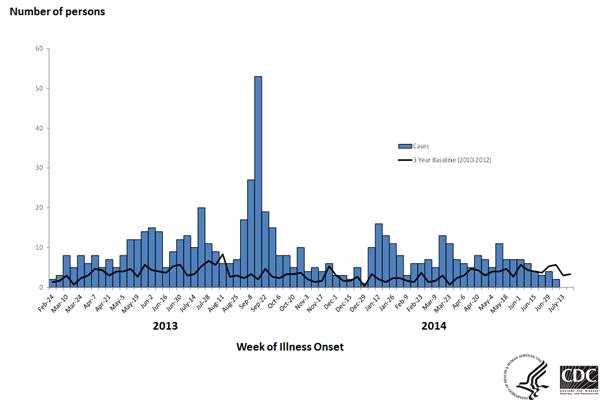Essential details about the epidemic were revealed by the epi curve, including how quickly it was spreading, what kind of food caused it, and whether it was still present. The epi curve revealed changes in the outbreak’s illness count over time (Center for Disease Control and Prevention [CDC], 2014a). The epi curve was updated as further infections were found throughout the outbreak investigation (CDC, 2014a). In figure 1, the initial and last illnesses in the outbreak that were reported are shown on the left to right sloping epi curve. How many persons were unwell on each date throughout the outbreak was shown from bottom to top.

The Definition of a Case
According to the Dictionary of Epidemiology, a case refers to a community or research group member identified as having the disease, health problem, or condition under the study. (CDC, 2014b).
How a Confirmed, Probable, and Possible Case Were Distinguished
A confirmed case was proved in a lab or fit the clinical case specifications and was pharmacologically connected to another confirmed occurrence. A probable case fit the clinical case specifications, had no serologic or virologic evaluation and was classified as possible by the CDC (2014b). On the other hand, a possible case matched the clinical requirements of the case definition but lacked epidemiological or laboratory proof of the disease in question.
The Outbreak’s Time Trend
Between March 1, 2013, and July 11, 2014, 634 cases of infection with seven Salmonella Heidelberg pandemic strains were announced from 29 countries and Puerto Rico (CDC, 2014b). 38% of the sick people were hospitalized despite no recorded fatalities (CDC, 2014b). Californians made up about 77% of the reported ill patients (CDC, 2014b). The Foster Farms-related Salmonella pandemic was deemed to be over by the United States CDC in March 2017, 17 months after the first symptoms surfaced (CDC, 2014b). This was due to the reported infections declining to the expected level. Since 2013, Foster Farms has committed to a 5% company-wide Salmonella prevalence in whole body chickens and parts (CDC, 2014c). On the other hand, the USDA allows a limit of 9.8% for the total body weight of chickens and 15.4% for chicken parts (CDC, 2014c).
General Sense of the Outbreak’s Magnitude
Municipal, national and confederate authorities conducted epidemiological and lab analyses. The results showed that chicken under the Foster Farms brand was a significant contributor to the outbreak of the Salmonella Heidelberg sickness. The Salmonella Heidelberg outbreak strains were resistant to widely used antibiotics (CDC, 2014b). Antibiotic resistance has been linked to a higher likelihood of hospitalization in infected people, even though these antibiotics are not frequently used to remedy Salmonella gore ailments or other serious diseases. Uncooked chicken from any producer may have Salmonella pathogens. The CDC and USDA-FSIS have established acceptable levels of Salmonella, and businesses that sell chicken parts and whole birds for use in human food must abide by these standards.
Inferences about the Outbreak’s Pattern Spread
CDC colluded with agriculture, public health officials in various states, and the USDA-FSIS (U.S. Department of Agriculture’s Food Safety and Inspection Service) to perform laboratory, trace back and epidemiology investigations (CDC, 2014b). It was identified that Foster Farms chicken brand was the cause of the Salmonella Heidelberg infection outbreak (CDC, 2014b). The Salmonella outbreak persisted from June 2012 to April 2013, according to the CDC (2014c). The CDC published a list of all the nations that have recorded Salmonella occurrences connected to the Foster Farms poultry meat epidemic at the beginning of March. These states were West Virginia, Alaska, Alabama, California, Hawaii, Idaho, Montana, Virginia, Utah, Oregon, and Massachusetts.
Most Likely Period of Exposure
People with the epidemic strains of Salmonella Heidelberg have an exposure period that typically lasts 2 to 4 weeks (CDC, 2014a). This is the time it takes for a disease to be reported after being ill. Investigators typically determine that the sickness begins three days before the time allotted for sample collection.
References
Centers for Disease Control and Prevention. (2014). Epi Curves. Web.
Centers for Disease Control and Prevention. (2014). Multistate Outbreak of Multidrug
Resistant Salmonella Infections Linked to Foster Farms Brand Chicken. Web.
Centers for Disease Control and Prevention. (2014). Timeline of Events. Web.